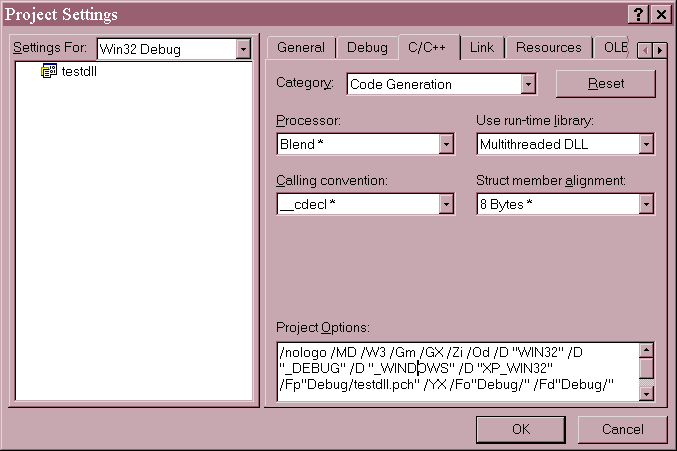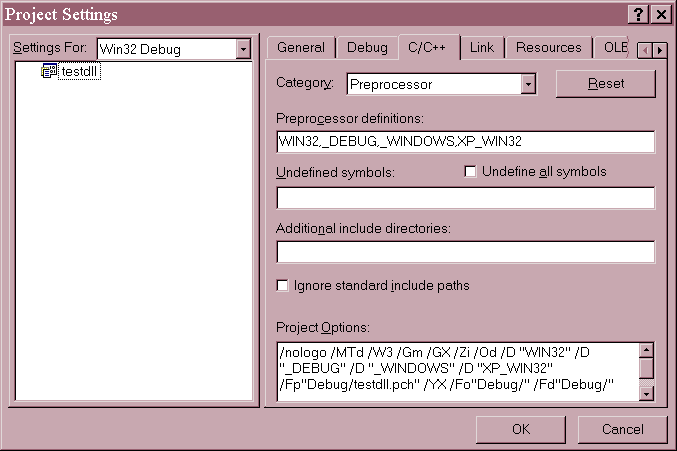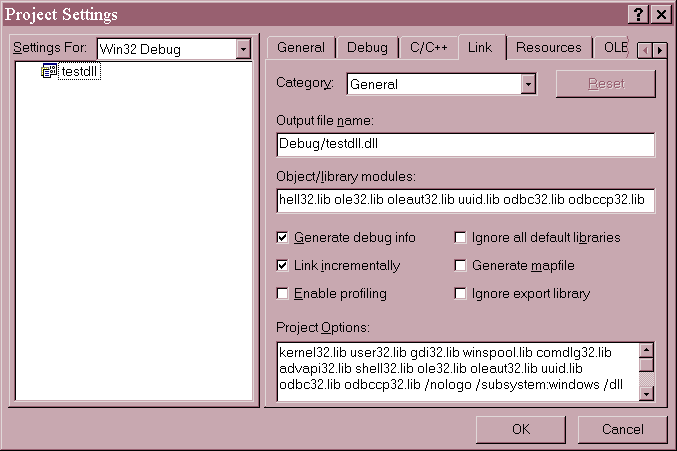Chapter 5
Writing a WAI Application in C++
- Declare a class that derives from the Netscape
WAIWebApplicationServicebase class. See "Declaring a Class for Your Web Service" - Define a
Runmethod for processing the incoming HTTP request. See "Defining a Method to Process Requests". - Define a
getServiceInfomethod for returning information about the service and its version. - Create an instance of your class and register your service to the web server's host machine. (For instructions, see "Registering Your Web Application Service".)
Before continuing on, note the following points:
- You must include the
ONESrvPI.hppheader file when writing a WAI application in C++: - The web server includes a sample C++ application that demonstrates how you can use WAI to write a web application service. The example is located in the
server_root/wai/examples/WASPdirectory on UNIX and theserver_root\wai\examples\WASPdirectory on Windows NT. - If you are using Visual C++ you need follow the instructions in Setting up Microsoft Visual C++ for use with WAI (Windows NT only) to set up your Visual C++ environment specifically for WAI.
#include "ONESrvPI.hpp"
This header file declares the C++ classes available in WAI.
You can follow this example as a guideline for writing and compiling your
application.
Setting up Microsoft Visual C++ for use
with WAI (Windows NT only)
Follow these steps when setting up your C++ project in Microsoft Visual C++. These steps are specific to Microsoft Visual C++ version 5.0.
- Specify the type of application you want to write.
- Console application
- Windows application
- DLL application
- Fill in the Project Name field.
- Add the project files.
- Specify that the code be generated using the
multi-threaded dllrun-time library.
Choose New from the File menu. Click the Projects tab and select the type
of application you want to write from this list:
Type the name of the project in the Project Name field and click OK.
From the Project menu, choose Add to Project and then choose Files. Use
the file browser to add the files you want to include in your project.
From the Project menu, select Settings. Click the C/C++ tab and choose
Code Generation from the pull-down menu next to the Category option
(see Figure 5.1).
Choose Multithreaded DLL from pull-down menu next to the "Use run-time
library" option.

- Specify XP_WIN32 as the macro definition.
Click Settings from the Project menu. Click the C/C++ tab and choose
Preprocessor from the Category option menu (see Figure 5.2).

Add XP_WIN32 to the Preprocessor Definitions field.
- In the field labeled "Additional include directories," type the names of any additional
includedirectories. - Add any additional libraries to list of libraries.
Add the
include file directories (../../include,..\..\include)
Alternatively, you can add the
include file directories by choosing Options
from the Tools menu and clicking the Directories tab. Choose "Include files"
from the "Show directories for" field, then add the include directories to
the list.
Choose Settings from the Project menu. Click the Link tab in the Project
Settings dialog box. Choose General from the pull-down menu next to the
Category option. In the "Object/docs modules" field, type the names of
additional libraries. See Figure 5.3.
 If you are using the Visual C++ Debug, do not use the
If you are using the Visual C++ Debug, do not use the ALLOC and FREE executables. They conflict with the WAI API functions and can cause unpredictable results.
Declaring a Class for Your Web Service
The first step in developing a WAI application in C++ is to declare a class that derives from the NetscapeWAIWebApplicationService base class. (This class represents a web application service.)
For example, the WASP example provided with the web server declares a WebApplicationServicePrototype class, which is derived from the WAIWebApplicationService base class:
//
// Declare a WAS class deriving from Netscape base class
//
class WebApplicationServicePrototype: public WAIWebApplicationService
{
public:
WebApplicationServicePrototype(const char *object_name = (const char *)NULL)
;
long Run(WAIServerRequest_ptr session);
char *getServiceInfo();
};
WebApplicationServicePrototype::WebApplicationServicePrototype(const char *object_name):WAIWebApplicationService(object_name)
{
}
...
The class that you define represents your web service. You need to define the following methods for your class; these methods are virtual methods in the WAIWebApplicationService base class:
RungetServiceInfo
This method is called by the web server to process HTTP requests for this
service. For details on defining this method, see "Defining a Method to
Process Requests".
This method returns information about your web service (such as version
information). For details on defining this method, see "Providing
Information About the Service".
Defining a Method to Process Requests
The method that processes incoming HTTP requests (not all requests, just the requests directed specifically at your service) should use the following syntax:long Run(WAIServerRequest_ptr session);
session represents the HTTP request to be processed. You can call the methods of this object to get data from the request, set data in the response headers, and send the response back to the client.
The rest of this section explains how you can use these methods and objects to process the request. WAI functions enable you to do the following tasks:
Getting Data from the Request
Using an object of theWAIServerRequest class (see the section "netscape::WAI::HttpServerRequest" for details), you can get data from the client's HTTP request. You can call functions accomplish the following tasks:
Getting Headers from the HTTP Request
Given an object of theWAIServerRequest class, you can get headers from the corresponding HTTP request by calling the getRequestHeader method. For example, the following section of code gets the user-agent HTTP request header from the incoming request:
long
WebApplicationServicePrototype::Run(WAIServerRequest_ptr session)
{
char *var = 0;
ostrstream outstr;
...
if (session->getRequestHeader("user-agent", var) == WAISPISuccess){
outstr << "User Agent: " << var;
StringDelete(var);
}
outstr << endl;
...
}
In addition to HTTP headers, you can get other types of information (such as CGI 1.1 environment variables) from the HTTP request by calling the getRequestInfo method of the WAIServerRequest class.
The section "getRequestInfo" lists the types of information you can retrieve from the request. Note that the CGI 1.1 environment variables that describe the server are accessible through the getInfo method. See "Getting Information about the Server" for details.
The following section of code gets and prints the value of the REMOTE_ADDR CGI 1.1 environment variable for the incoming request:
long
WebApplicationServicePrototype::Run(WAIServerRequest_ptr session)
{
char *var = 0;
ostrstream outstr;
...
if (session->getRequestInfo("REMOTE_ADDR", var) == WAISPISuccess){
outstr << "Client IP Address: " << var;
StringDelete(var);
}
outstr << endl;
...
}
Getting Information about the Server
WAI also provides methods for getting information about the server, such as the server identifier or CGI 1.1 environment variables that describe the server (for example, SERVER_NAME or SERVER_PORT).
These methods are available as part of the WAIServerContext class (for more information, see the section "netscape::WAI::HttpServerContext"). You can get an object of this class by using the getContext method of the WAIServerRequest class.
For example, the following section of code gets an WAIServerContext object:
long
WebApplicationServicePrototype::Run(WAIServerRequest_ptr session)
{
...
WAIServerContext_ptr context = session->getContext();
...
}
To get information about the server, you can call the getInfo method of the WAIServerContext object and specify the type of information that you want to retrieve. For example, the following section of code gets the value of the SERVER_PORT CGI 1.1 environment variable:
long
WebApplicationServicePrototype::Run(WAIServerRequest_ptr session)
{
int port_num;
ostrstream outstr;
WAIServerContext_ptr context = session->getContext();
...
if (context->getInfo("SERVER_PORT", port_num) == WAISPISuccess){
outstr << "Port Number: " << var;
StringDelete(var);
}
outstr << endl;
}
...
}
For a list of the types of information you can retrieve from this method, see the section "getInfo".
You can also use methods that specifically retrieve a certain type of information. For example, to get the port number that the server listens to, you can call the getPort method:
long
WebApplicationServicePrototype::Run(WAIServerRequest_ptr session)
{
int port_num = 0;
ostrstream outstr;
WAIServerContext_ptr context = session->getContext();
...
if ((port_num = context->getPort()) != 0){
outstr << "Port Number: " << var;
StringDelete(var);
}
outstr << endl;
}
...
}
For details on getting server information, see the section "netscape::WAI::HttpServerContext".
Getting and Setting Cookies in the Client
Before a client accesses a URL, the client checks the domain name in the URL against the cookies that it has. If any cookies are from the same domain as the URL, the client includes a header in the HTTP request that contains the name/value pairs from the matching cookies.
The Cookie header has the following format:
Cookie: name=value; [name1=value1; name2=value2 ... ]
To get these name/value pairs from the HTTP request, call the getCookie method. To set your own name/value pairs in a client, call the setCookie method.
The following example illustrates how you can use these methods to get and set cookies in the client.
long
WebApplicationServicePrototype::Run(WAIServerRequest_ptr session)
{
...
char *cookiebuff = NULL;
/* If no cookie has been set in the client, set a cookie. */
if (session->getCookie(cookiebuff)== WAISPIFailure)
session->setCookie("MY_NAME", "My Value", "", "", "/", WAI_FALSE);
...
}
Sending the Response Back to the Client
Methods of the HttpServerRequest class also allow you to control the response sent back to the client. You can call these functions to accomplish the following tasks:
Setting Headers in the Response
WAI includes functions that you can use to set headers in the response that you want sent back to the client. You can call theaddResponseHeader method to set any header in the response. For example, the following section of code adds the Pragma header to the response:
long
WebApplicationServicePrototype::Run(WAIServerRequest_ptr session)
{
...
session->addResponseHeader("Pragma", "no-cache");
...
}
You can also call functions that set specific types of headers. For example, you can call:
setResponseContentTypeto specify the content type of the response (theContent-typeheader)setResponseContentLengthto specify the length of the response in bytes (theContent-lengthheader)
Setting the Status of the Response
To set the status of the response sent back to the client, call thesetResponseStatus method. For example, the following section of code sets the response code to a 404 status code ("File Not Found"):
long
WebApplicationServicePrototype::Run(WAIServerRequest_ptr session)
{
...
session->setResponseStatus(404, "");
...
}
Sending the Response
After you have specified the length of the content you want sent back to the client, you can start sending the response to the client. Call the StartResponse method to start sending the response.
To send the rest of the data to the client, call the WriteClient method.
The following example sends the string Hello World back to the client:
long
WebApplicationServicePrototype::Run(WAIServerRequest_ptr session)
{
...
/* Specify the string that you want to send back to the client. */
char *buffer = "Hello World\n";
size_t bufflen = strlen(buffer);
/* Specify the length of the data that you are about to send back. */
session->setResponseContentLength(bufflen);
/* Start sending the response back to the client. */
session->StartResponse();
/* Write the string to the client. */
session->WriteClient((const unsigned char *)buffer, bufflen);
...
}
Redirecting Users to Another Page
In your WAI application, you can also redirect users to a different page than the requested page. You can either automatically redirect the user to a new page, or you can present the user with a link to click on manually.
To automatically redirect the user to a different page, you can do the following:
- Call the
addResponseHeader method to add a Location header, which points to the new location.
- Call the
setResponseStatus method to set the response status to 301 (if the page has permanently moved) or 302 (if the page has temporarily moved).
- Call the
StartResponse method to send the response back to the client.
long
WebApplicationServicePrototype::Run(WAIServerRequest_ptr session)
{
session->addResponseHeader("Location", "http://www.newsite.com/");
session->setResponseStatus(301, "Moved permanently to newsite!");
session->StartResponse();
return 0;
}To give the user the choice of going to the new location (rather than automatically redirecting the URL), you can call the
RespondRedirect method:
long
WebApplicationServicePrototype::Run(WAIServerRequest_ptr session)
{
session->RespondRedirect("http://www.newsite.com/");
session->StartResponse();
return 0;
}
Calling this method will send the following page back to the client:
Moved Temporarily
This document has moved to a new location. Please update your documents and hotlists accordingly.
The word "location" on this page is a link pointing to the new location of the page.
Providing Information About the Service
Part of the WAIWebApplicationService base class is the virtual getServiceInfo method. When you write your web application class (which is derived from the base class), you need to include a definition of this method.
The getServiceInfo method should provide information about the web service, such as the name of the author, the version of the service, and so on.
The following section of code defines the getServiceInfo method for a web service class WebApplicationServicePrototype. The example uses the StringDup method to allocate memory for the returned string.
...
char *
WebApplicationServicePrototype::getServiceInfo(void)
{
return StringDup("My Test Web Service. Version 1.0\nCopyright Netscape Communications Corporation\nAuthor: Mozilla\n");
}
...
Registering Your Web Application Service
Next, you need to create an instance of your class and assign an instance name to the object. You need to register your web service to the web server under this instance name. The instance name that you select for your web service can be an arbitrary name; it does not need to be the same name as your application. (For example, if your application is named MyApp or MyApp.exe, your instance name can be MyWebService. They do not need to have the same name.)
Note, however, that your instance name must be unique. No other registered WAI application can have the same name.
Registering With a Web Server
To register your application with the web server's built-in name service, call the RegisterService method. Pass the name of the web server's hostname and port number as an argument (in the form hostname:portnumber) to this method.
Note that if your web server is running with SSL enabled, you need to specify a different value for this argument. For details, see "Registering With a Web Server".
The following section of code creates the web service ExeFoo from the web service class WebApplicationServicePrototype. The example registers this object to the web server under the instance name MyService.
...
WAIBool rv;
char *host = "myhost.mydomain.com:81";
char *instanceName = "MyService";
...
/* Create the web service. */
WebApplicationServicePrototype ExeFoo(instanceName);
/* Register the web service. */
rv = ExeFoo.RegisterService(host);
/* Provide feedback on the result of the registration attempt. */
if (rv == WAI_FALSE) {
printf("Failed to register with %s\n", host);
} else {
printf("Successfully registered with %s\n", host);
}
...
Registering With an SSL-Enabled Server
Typically, when you call the RegisterService or the WAIregisterService function to register your web service, you pass the host name and port number of your web server as an argument.
The function constructs a URL to the web server's built-in naming service and gets the object reference for this naming service. This object reference is used to register your application.
If your web server has SSL enabled, the RegisterService or WAIregisterService function cannot get the naming service object reference in the manner described above. Instead, it needs to use the Interoperable Object Reference (IOR) file to get the object reference for the naming service.
To find the IOR file, the RegisterService function assembles a path to the file using the following information:
If your web server does not use the default values for either of these, you must set environment variables to identify the correct values before running your WAI application:
-
For example, suppose that your server is installed under
/export/netscape/suitespot. In a C shell, you need to set the following environment variable before running your WAI application:
setenv NS_SERVER_ROOT /export/netscape/suitespotFor example, suppose that your server is running on the machine
preston and your server identifier is https-webserver instead of https-preston. In C shell, you need to set the following environment variable before running your WAI application:
setenv NS_SERVER_ID https-webserver
Running Your Web Service
After you write and compile your application, you can run your application to make your web service available. The web server should recognize your application, if you've registered it (see "Registering Your Web Application Service").
End users can access your service by going to the URL:
http://server_name:port_number/iiop/instance_name
For example, you can access the C++ WASP example by going to the URL:
http://server_name:port_number/iiop/WASP
[Contents] [Previous] [Next] [Index]
Last Updated: 12/04/97 16:12:20
Any sample code included above is provided for your use on an "AS IS" basis, under the Netscape License Agreement - Terms of Use